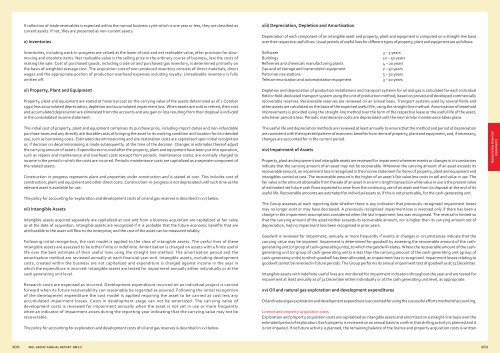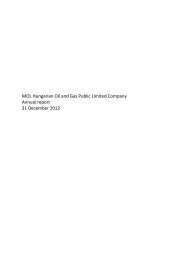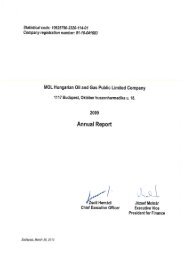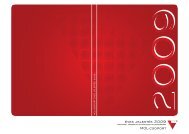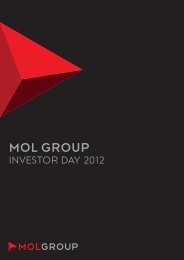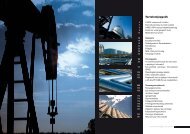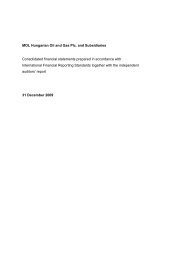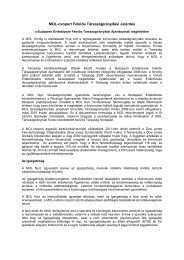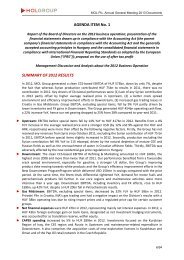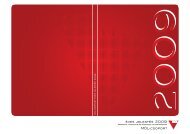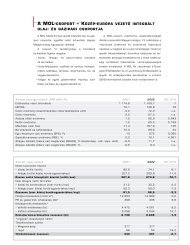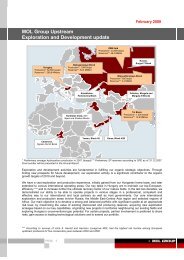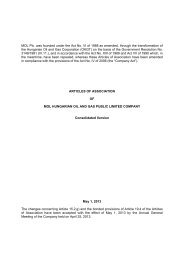MOL GROUP Annual Report
MOL GROUP Annual Report
MOL GROUP Annual Report
- No tags were found...
Create successful ePaper yourself
Turn your PDF publications into a flip-book with our unique Google optimized e-Paper software.
If collection of trade receivables is expected within the normal business cycle which is one year or less, they are classified ascurrent assets. If not, they are presented as non-current assets.x) Inventoriesxiii) Depreciation, Depletion and AmortisationDepreciation of each component of an intangible asset and property, plant and equipment is computed on a straight-line basisover their respective useful lives. Usual periods of useful lives for different types of property, plant and equipment are as follows:Inventories, including work-in-progress are valued at the lower of cost and net realisable value, after provision for slowmovingand obsolete items. Net realisable value is the selling price in the ordinary course of business, less the costs ofmaking the sale. Cost of purchased goods, including crude oil and purchased gas inventory, is determined primarily onthe basis of weighted average cost. The acquisition cost of own produced inventory consists of direct materials, directwages and the appropriate portion of production overhead expenses including royalty. Unrealisable inventory is fullywritten off.SoftwareBuildingsRefineries and chemicals manufacturing plantsGas and oil storage and transmission equipmentPetrol service stationsTelecommunication and automatisation equipment3 – 5 years10 – 50 years4 – 20 years7 – 50 years5 – 30 years3 – 10 yearsxi) Property, Plant and EquipmentProperty, plant and equipment are stated at historical cost (or the carrying value of the assets determined as of 1 October1991) less accumulated depreciation, depletion and accumulated impairment loss. When assets are sold or retired, their costand accumulated depreciation are eliminated from the accounts and any gain or loss resulting from their disposal is includedin the consolidated income statement.Depletion and depreciation of production installations and transport systems for oil and gas is calculated for each individualfield or field-dedicated transport system using the unit of production method, based on proved and developed commerciallyrecoverable reserves. Recoverable reserves are reviewed on an annual basis. Transport systems used by several fields andother assets are calculated on the basis of the expected useful life, using the straight-line method. Amortisation of leaseholdimprovements is provided using the straight-line method over the term of the respective lease or the useful life of the asset,whichever period is less. Periodic maintenance costs are depreciated until the next similar maintenance takes place.The initial cost of property, plant and equipment comprises its purchase price, including import duties and non-refundablepurchase taxes and any directly attributable costs of bringing the asset to its working condition and location for its intendeduse, such as borrowing costs. Estimated decommissioning and site restoration costs are capitalized upon initial recognitionor, if decision on decommissioning is made subsequently, at the time of the decision. Changes in estimates thereof adjustthe carrying amount of assets. Expenditures incurred after the property, plant and equipment have been put into operation,such as repairs and maintenance and overhead costs (except from periodic maintenance costs), are normally charged toincome in the period in which the costs are incurred. Periodic maintenance costs are capitalized as a separate component ofthe related assets.Construction in progress represents plant and properties under construction and is stated at cost. This includes cost ofconstruction, plant and equipment and other direct costs. Construction-in-progress is not depreciated until such time as therelevant asset is available for use.The policy for accounting for exploration and development costs of oil and gas reserves is described in xv) below.xii) Intangible AssetsIntangible assets acquired separately are capitalized at cost and from a business acquisition are capitalized at fair valueas at the date of acquisition. Intangible assets are recognized if it is probable that the future economic benefits that areattributable to the asset will flow to the enterprise; and the cost of the asset can be measured reliably.Following initial recognition, the cost model is applied to the class of intangible assets. The useful lives of theseintangible assets are assessed to be either finite or indefinite. Amortisation is charged on assets with a finite usefullife over the best estimate of their useful lives using the straight line method. The amortisation period and theamortisation method are reviewed annually at each financial year-end. Intangible assets, excluding developmentcosts, created within the business are not capitalized and expenditure is charged against income in the year inwhich the expenditure is incurred. Intangible assets are tested for impairment annually either individually or at thecash generating unit level.Research costs are expensed as incurred. Development expenditure incurred on an individual project is carriedforward when its future recoverability can reasonably be regarded as assured. Following the initial recognitionof the development expenditure the cost model is applied requiring the asset to be carried at cost less anyaccumulated impairment losses. Costs in development stage can not be amortized. The carrying value ofdevelopment costs is reviewed for impairment annually when the asset is not yet in use or more frequentlywhen an indicator of impairment arises during the reporting year indicating that the carrying value may not berecoverable.The policy for accounting for exploration and development costs of oil and gas reserves is described in xv) below.The useful life and depreciation methods are reviewed at least annually to ensure that the method and period of depreciationare consistent with the expected pattern of economic benefits from items of property, plant and equipment, and, if necessary,changes are accounted for in the current period.xiv) Impairment of AssetsProperty, plant and equipment and intangible assets are reviewed for impairment whenever events or changes in circumstancesindicate that the carrying amount of an asset may not be recoverable. Whenever the carrying amount of an asset exceeds itsrecoverable amount, an impairment loss is recognized in the income statement for items of property, plant and equipment andintangibles carried at cost. The recoverable amount is the higher of an asset’s fair value less costs to sell and value in use. Thefair value is the amount obtainable from the sale of an asset in an arm’s length transaction while value in use is the present valueof estimated net future cash flows expected to arise from the continuing use of an asset and from its disposal at the end of itsuseful life. Recoverable amounts are estimated for individual assets or, if this is not practicable, for the cash-generating unit.The Group assesses at each reporting date whether there is any indication that previously recognised impairment lossesmay no longer exist or may have decreased. A previously recognised impairment loss is reversed only if there has been achange in the impairment assumptions considered when the last impairment loss was recognised. The reversal is limited sothat the carrying amount of the asset neither exceeds its recoverable amount, nor is higher than its carrying amount net ofdepreciation, had no impairment loss been recognised in prior years.Goodwill is reviewed for impairment, annually or more frequently if events or changes in circumstances indicate that thecarrying value may be impaired. Impairment is determined for goodwill by assessing the recoverable amount of the cashgeneratingunit (or group of cash-generating units), to which the goodwill relates. Where the recoverable amount of the cashgeneratingunit (or group of cash-generating units) is less than the carrying amount of the cash-generating unit (group ofcash-generating units) to which goodwill has been allocated, an impairment loss is recognized. Impairment losses relating togoodwill cannot be reversed in future periods. The Group performs its annual impairment test of goodwill as at 31 December.Intangible assets with indefinite useful lives are monitored for impairment indicators throughout the year and are tested forimpairment at least annually as of 31 December either individually or at the cash generating unit level, as appropriate.xv) Oil and natural gas exploration and development expendituresOil and natural gas exploration and development expenditure is accounted for using the successful efforts method of accounting.Licence and property acquisition costsExploration and property acquisition costs are capitalized as intangible assets and amortized on a straight-line basis over theestimated period of exploration. Each property is reviewed on an annual basis to confirm that drilling activity is planned and itis not impaired. If no future activity is planned, the remaining balance of the licence and property acquisition costs is writtenNotes to the financialstatements100 <strong>MOL</strong> Group annual report 2010 101


